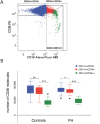Elevated atherosclerosis-related gene expression, monocyte activation and microparticle-release are related to increased lipoprotein-associated oxidative stress in familial hypercholesterolemia
- PMID: 25875611
- PMCID: PMC4395270
- DOI: 10.1371/journal.pone.0121516
Elevated atherosclerosis-related gene expression, monocyte activation and microparticle-release are related to increased lipoprotein-associated oxidative stress in familial hypercholesterolemia
Abstract
Objective: Animal and in vitro studies have suggested that hypercholesterolemia and increased oxidative stress predisposes to monocyte activation and enhanced accumulation of oxidized LDL cholesterol (oxLDL-C) through a CD36-dependent mechanism. The aim of this study was to investigate the hypothesis that elevated oxLDL-C induce proinflammatory monocytes and increased release of monocyte-derived microparticles (MMPs), as well as up-regulation of CD36, chemokine receptors and proinflammatory factors through CD36-dependent pathways and that this is associated with accelerated atherosclerosis in subjects with heterozygous familial hypercholesterolemia (FH), in particular in the presence of Achilles tendon xanthomas (ATX).
Approach and results: We studied thirty FH subjects with and without ATX and twenty-three healthy control subjects. Intima-media thickness (IMT) and Achilles tendon (AT) thickness were measured by ultrasonography. Monocyte classification and MMP analysis were performed by flow cytometry. Monocyte expression of genes involved in atherosclerosis was determined by quantitative PCR. IMT and oxLDL-C were increased in FH subjects, especially in the presence of ATX. In addition, FH subjects had elevated proportions of intermediate CD14++CD16+ monocytes and higher circulating MMP levels. Stepwise linear regression identified oxLDL-C, gender and intermediate monocytes as predictors of MMPs. Monocyte expression of pro-atherogenic and pro-inflammatory genes regulated by oxLDL-C-CD36 interaction was increased in FH, especially in ATX+ subjects. Monocyte chemokine receptor CX3CR1 was identified as an independent contributor to IMT.
Conclusions: Our data support that lipoprotein-associated oxidative stress is involved in accelerated atherosclerosis in FH, particularly in the presence of ATX, by inducing pro-inflammatory monocytes and increased release of MMPs along with elevated monocyte expression of oxLDL-C-induced atherosclerosis-related genes.
Conflict of interest statement
Figures



Similar articles
-
The Impact of Lipoprotein-Associated Oxidative Stress on Cell-Specific Microvesicle Release in Patients with Familial Hypercholesterolemia.Oxid Med Cell Longev. 2016;2016:2492858. doi: 10.1155/2016/2492858. Epub 2016 Jan 27. Oxid Med Cell Longev. 2016. PMID: 26925191 Free PMC article.
-
Factors Associated with Carotid Atherosclerosis and Achilles Tendon Thickness in Japanese Patients with Familial Hypercholesterolemia: A Subanalysis of the Familial Hypercholesterolemia Expert Forum (FAME) Study.J Atheroscler Thromb. 2022 Jun 1;29(6):906-922. doi: 10.5551/jat.62925. Epub 2021 Jun 10. J Atheroscler Thromb. 2022. PMID: 34108342 Free PMC article.
-
Different functions of monocyte subsets in familial hypercholesterolemia: potential function of CD14+ CD16+ monocytes in detoxification of oxidized LDL.FASEB J. 2009 Mar;23(3):866-74. doi: 10.1096/fj.08-118240. Epub 2008 Nov 10. FASEB J. 2009. PMID: 19001052
-
Markers of atherosclerotic development in children with familial hypercholesterolemia: a literature review.Atherosclerosis. 2014 Aug;235(2):299-309. doi: 10.1016/j.atherosclerosis.2014.05.917. Epub 2014 May 20. Atherosclerosis. 2014. PMID: 24908240 Review.
-
Is there a genetic basis for resistance to atherosclerosis?Atherosclerosis. 2002 Jan;160(1):1-10. doi: 10.1016/s0021-9150(01)00664-5. Atherosclerosis. 2002. PMID: 11755917 Review.
Cited by
-
Native Low-Density Lipoproteins Act in Synergy with Lipopolysaccharide to Alter the Balance of Human Monocyte Subsets and Their Ability to Produce IL-1 Beta, CCR2, and CX3CR1 In Vitro and In Vivo: Implications in Atherogenesis.Biomolecules. 2021 Aug 7;11(8):1169. doi: 10.3390/biom11081169. Biomolecules. 2021. PMID: 34439835 Free PMC article.
-
The relationship of redox signaling with the risk for atherosclerosis.Front Pharmacol. 2024 Aug 1;15:1430293. doi: 10.3389/fphar.2024.1430293. eCollection 2024. Front Pharmacol. 2024. PMID: 39148537 Free PMC article. Review.
-
Review: the Multiple Roles of Monocytic Microparticles.Inflammation. 2016 Aug;39(4):1277-84. doi: 10.1007/s10753-016-0381-8. Inflammation. 2016. PMID: 27216803 Review.
-
The Association Between Monocyte Subsets and Cardiometabolic Disorders/Cardiovascular Disease: A Systematic Review and Meta-Analysis.Front Cardiovasc Med. 2021 Feb 17;8:640124. doi: 10.3389/fcvm.2021.640124. eCollection 2021. Front Cardiovasc Med. 2021. PMID: 33681309 Free PMC article.
-
Microvesicles as Emerging Biomarkers and Therapeutic Targets in Cardiometabolic Diseases.Genomics Proteomics Bioinformatics. 2018 Feb;16(1):50-62. doi: 10.1016/j.gpb.2017.03.006. Epub 2018 Feb 17. Genomics Proteomics Bioinformatics. 2018. PMID: 29462670 Free PMC article. Review.
References
-
- Libby P (2007) Inflammatory mechanisms: the molecular basis of inflammation and disease. Nutr Rev 65: S140–146. - PubMed
-
- Ziegler-Heitbrock HW (1996) Heterogeneity of human blood monocytes: the CD14+ CD16+ subpopulation. Immunol Today 17: 424–428. - PubMed
-
- Frankenberger M, Sternsdorf T, Pechumer H, Pforte A, Ziegler-Heitbrock HW (1996) Differential cytokine expression in human blood monocyte subpopulations: a polymerase chain reaction analysis. Blood 87: 373–377. - PubMed
Publication types
MeSH terms
Substances
LinkOut - more resources
Full Text Sources
Other Literature Sources
Medical
Research Materials
Miscellaneous

